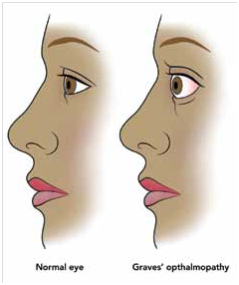HYPERTHYROIDISM
Posted on March 15th, 2016 by Andries Lodder
HYPERTHYROIDISM
By Dr Kershlin Naidu, Endocrinologist and Specialist Physician, Netcare Waterfall City Hospital
 Last month, we focused on Hypothyroidism where the thyroid gland does not produce enough thyroid hormone. This month’s article discusses an overactive thyroid.
Last month, we focused on Hypothyroidism where the thyroid gland does not produce enough thyroid hormone. This month’s article discusses an overactive thyroid.
To recap, the thyroid gland is a butterfly-shaped endocrine gland that is normally located in the lower front of the neck. The thyroid makes thyroxine, which is secreted into the blood and then carried to every tissue in the body. Thyroxine is a body chemical (hormone) that is circulated around the body in the bloodstream. It helps to keep the body’s functions (the metabolism) working at the correct pace. Many cells and tissues in the body need thyroxine to keep them functioning correctly. Thyroxine helps the body use energy, stay warm and keep the brain, heart, muscles, and other organs working as they should.
Hyperthyroidism is a condition where the thyroid produces more thyroxine than is needed by the body. It is also referred to as thyrotoxicosis, or an over-active thyroid. It can occur if you have:
- Graves’ disease (the most common cause);
- Toxic multinodular goitre (a goitre is an enlarged thyroid gland);
- Solitary toxic thyroid adenoma (an adenoma is a clump of cells);
- Thyroiditis (inflammation of the thyroid gland).
It can also occur when too much replacement thyroxine (levothyroxine) is taken as a treatment for an under-active thyroid (hypothyroidism). Hyperthyroidism is more common in women. About 8 in 100 women and 1 in 100 men develop hyperthyroidism at some stage of their lives. It can occur at any age.
SYMPTOMS OF HYPERTHYROIDISM INCLUDE:
- Being restless, nervous, emotional, irritable, sleeping poorly and ‘always on the go’;
- Tremor of your hands;
- Warm, moist hands;
- Weight loss, despite an increased appetite;
- Palpitations (sensation of your heart beating fast);
- Rapid pulse;
- Sweating;
- Heat intolerance / preference for cooler weather;
- Increased thirst;
- Diarrhoea or needing to go to the toilet more often than normal;
- Shortness of breath;
- Skin problems such as hair thinning and itchiness;
- Menstrual changes (in women) – your periods may become very light or infrequent;
- Fatigue;
- Muscle weakness (difficulty climbing stairs, standing from a seated position or combing your hair);
- Swelling of your thyroid gland (a goitre);
- Eye problems (bulging, redness, itchiness or dryness of your eyes) if you have Graves’ disease.
Most people with hyperthyroidism do not have all the symptoms but a combination of two or more is common. Symptoms usually develop slowly over several weeks. All the symptoms can be caused by other problems and so the diagnosis may not be obvious at first. Symptoms may be mild to start with but become worse as the level of thyroxine in the blood gradually rises.
CAUSES OF HYPERTHYROIDISM
Graves’ disease
This is the most common cause of hyperthyroidism. It is not clear why Graves’ disease develops in most people, although it is more common in certain families. There may also be family members with other autoimmune diseases (eg. diabetes, rheumatoid arthritis and myasthenia gravis).
Graves’ disease is an autoimmune condition. The immune system normally makes antibodies (tiny proteins that travel in the bloodstream) to attack bacteria, viruses and other germs. In autoimmune diseases, the immune system makes antibodies against tissues of the body. In Graves’ disease the body’s immune system turns against the thyroid gland and produces an antibody that stimulates the thyroid gland to produce too much thyroid hormone. Autoimmune thyroid disease has a strong genetic component. It is thought that something triggers the immune system to make these antibodies. The trigger is not known. Stress also seems to play a role and sometimes people with Graves’ disease may have experienced major stresses in their lives a year or so before Graves’ disease is diagnosed.
Graves’ disease is most common in women between the ages of 20 and 40 years, but can occur at any age in men or women. The thyroid gland enlarges (called a goitre) and makes excessive amounts of thyroid hormone, causing symptoms of hyperthyroidism.
Some people develop eye problems (called Graves’ ophthalmopathy or orbitopathy), which causes dry, irritated or red eyes, and in severe cases may cause double vision. Others develop swelling behind or around the eyes that causes the eyes to bulge out, or inflammation of muscle in the eyelids that can cause excessive lid opening. The more severe manifestations of Graves’ eye disease are uncommon, except in smokers.
This is a less common cause of hyperthyroidism and is characterized by one or more nodules or lumps in the thyroid that may gradually grow and increase their activity so that the total output of thyroid hormone into the blood is greater than normal. This condition is known as toxic nodular or multinodular goitre.
Thyroiditis
Painless (“silent or lymphocytic”) thyroiditis and postpartum thyroiditis are disorders in which the thyroid becomes temporarily inflamed and releases thyroid hormone into the bloodstream, causing hyperthyroidism.
Postpartum thyroiditis can occur several months after delivery. The hyperthyroid symptoms may last for several months, often followed by several months of hypothyroid symptoms, such as fatigue, muscle cramps, bloating, and weight gain.
Subacute (granulomatous) thyroiditis is thought to be caused by a virus. It causes a painful, tender, enlarged thyroid gland. The thyroid becomes inflamed and releases thyroid hormone into the blood stream; the hyperthyroidism resolves when the viral infection improves, and may also be followed by several months of hypothyroid symptoms.
Other causes
Taking too much thyroid hormone medication for hypothyroidism. Some people who take the medicines amiodarone and lithium may develop hyperthyroidism. There are various other rare conditions that result in excess thyroxine being made.
DIAGNOSIS OF HYPERTHYROIDISM
A blood test can diagnose hyperthyroidism. A normal blood test will also rule it out if symptoms suggest that it may be a possible diagnosis. One or both of the following may be measured in a blood sample:
- Thyroid-stimulating hormone (TSH): A low level of TSH means that your thyroid gland is overactive and is making too much thyroxine.
- Thyroxine (T4). A high level of T4 confirms hyperthyroidism.
Other tests are sometimes done to clarify the situation and the cause. For example, another blood test that measures T3 is sometimes helpful and an ultrasound scan of the thyroid or a thyroid scan may be done if you have a nodular goitre. In people with Graves’ disease a blood test may detect specific autoantibodies which are commonly raised.
POSSIBLE COMPLICATIONS
If you have untreated hyperthyroidism:
- You have an increased risk of developing heart problems such as abnormal heart rhythm (atrial fibrillation), a weak heart (cardiomyopathy) or worsening angina and heart failure.
- If you are pregnant, you have an increased risk of developing some pregnancy complications.
- You have an increased risk of developing fragile bones (osteoporosis).
With treatment, the outlook is good. With successful treatment, most of the symptoms and risks of complications go.
TREATMENT OF HYPERTHYROIDISM
The main aim of treatment is to reduce your level of thyroxine to normal. Other problems, such as a large goitre (thyroid swelling) or associated eye problems, may also need treatment. Factors such as the underlying cause of the problem, your age and the size of any goitre are taken into account to decide on the best treatment plan.
Treatment options include the following:
Medicines (carbimazole / neomercazole) Carbimazole reduces the formation of thyroxine by an overactive thyroid gland. It may take 4 to 8 weeks of treatment for your thyroxine level to come down to normal. The dose of carbimazole needed to keep the thyroxine level normal varies from person to person. A high dose is usually given initially which is then reduced as your thyroxine levels come down.
Carbimazole can, rarely, affect your white blood cells which fight infection. If you develop a fever, sore throat, mouth ulcers or other symptoms of infection whilst taking carbimazole, you should stop taking it and see a doctor urgently for a blood test.
RADIOIODINE
This involves taking a drink, or swallowing a capsule, which contains radioactive iodine. The main use of iodine in the body is to make thyroxine. Therefore, the radioactive iodine builds up in the thyroid gland. As the radioactivity is concentrated in the thyroid gland, it destroys some thyroid tissue which reduces the amount of thyroxine that you make. The dose of radioactivity to the rest of the body is very low and is not dangerous. However, it is not suitable if you are pregnant or breast-feeding. In addition, after treatment, women should not become pregnant for at least six months and men are advised not to father children for at least four months.
Your specialist will give detailed advice regarding this form of therapy.
SURGERY
This involves removing part of your thyroid gland. It may be a good option if you have a large thyroid swelling (goitre) which is causing problems in your neck. If too much thyroid tissue is removed then you will be given thyroxine tablets to keep your thyroxine level normal. It is usually a safe operation but, as with all operations, there is a small risk.
TREATMENT FOR EYE PROBLEMS
You may need to see an eye specialist if you develop the eye problems of Graves’ disease. Relatively minor symptoms affect the eyes in about half of people with Graves’ disease. Measures such as artificial tears, sunglasses and eye protectors whilst you sleep may be sufficient to help.
However, about 1 in 20 people with Graves’ disease have severe eye changes. Treatment can then be more difficult and may include surgery, radiation treatment or steroid tablets. If you smoke, it is important that you try to stop. Smoking can actually make your eye problems worse.
BETA-BLOCKERS
Some people are given a beta-blocker medicine (eg. propranolol, atenolol, etc) for a few weeks whilst the level of thyroxine is reduced gradually by one of the above treatments. Betablockers can help to reduce symptoms of tremor, palpitations, sweating, agitation and anxiety.
Regular checks are recommended, even after you finish a successful treatment. It is very important to have regular blood tests to check that you have the right level of thyroid hormone (thyroxine) in your blood. This is because some people become hyperthyroid again at some time in the future. Others who have been treated successfully develop an underactive thyroid in the future. If this occurs, it can usually be treated easily with thyroxine tablets.
TO SUMMARISE
Hyperthyroidism is a condition where the thyroid produces more thyroxine than is needed by the body. Symptoms vary greatly amongst individuals and a diagnosis can be established with a blood test. Hyperthyroidism can be successfully treated with medication, radioactive iodine therapy or surgery.
Dr Kershlin Naidu
B.Med.Sci(NATAL), MBBCh(WITS), FCP(SA), MMed(WITS), FSEM(SA)
Endocrinologist / Specialist Physician Netcare Waterfall City Hospital
Room SF218, 2nd Floor, South Block.
Tel: 011 304 6865 (emergency on 011 304 6600
Email: drknaidu@waterfallhealth.co.za
Original post of article in Waterfall Estate News Magazine, Issue 5, 2015.
Tweet
